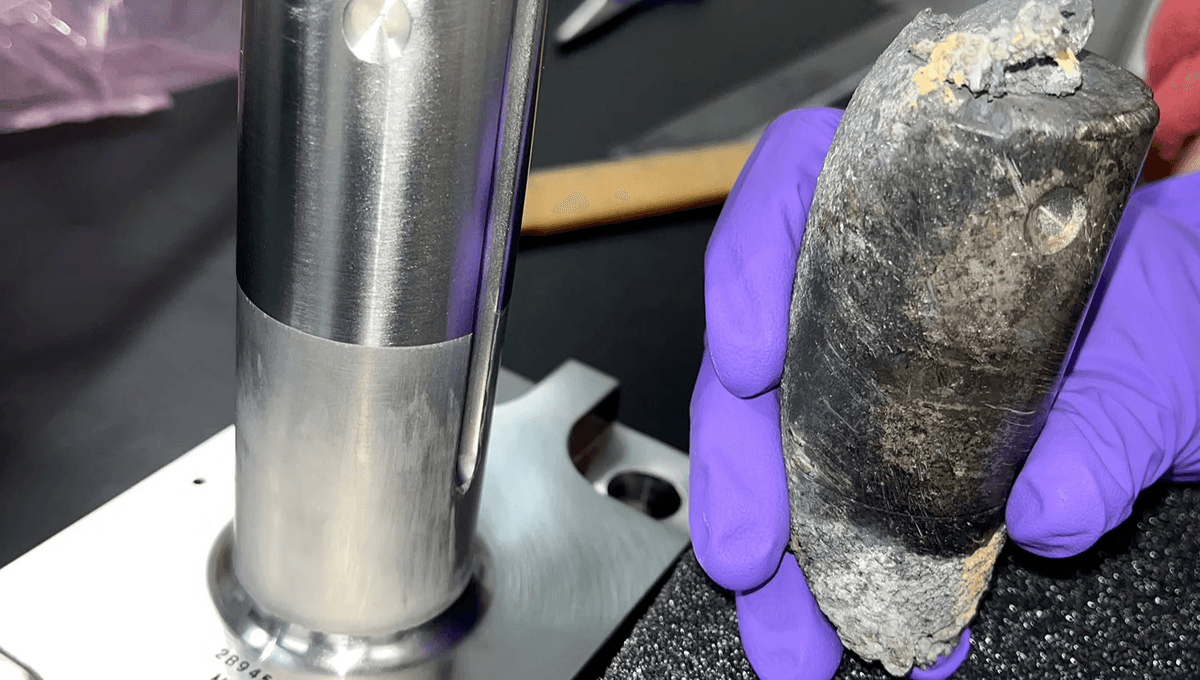Last month, a pallet of discarded batteries from the International Space Station (ISS) fell to Earth. Most of it burned up in the atmosphere or crashed into the Atlantic Ocean, but part of it ended up in Alejandro Otero’s house in Florida, and thanks to social media, Otero was able to contact NASA and get They look at the pieces. Now the agency has confirmed that it is indeed part of the International Space Station.
Based on the inspection, the agency determined that the debris was a pillar of NASA’s flight support equipment used to mount batteries on cargo pallets. NASA confirmed in a statement that the object is made of the metal alloy Inconel, weighs 1.6 pounds, is 4 inches tall and 1.6 inches in diameter.
The strut is a support rod, and although it was expected to burn up upon re-entry, this was not the case. A quick approximation of its terminal velocity suggests it could easily be moving in excess of 160 kilometers (100 miles) per hour. It is therefore not surprising that it passes through the depths of the Otros house. As you can see in the video below, it went through the tiled roof, ceiling, and through an occupied room on the second floor before getting stuck in the ceiling on the first floor.
It’s lucky no one was hurt. Otero tried multiple times to contact NASA directly, but no progress was made until he reached out to astronomer Jonathan McDowell on Twitter. Eventually, NASA got in touch and picked up the object for analysis.
What should you do if you find a piece of fallen space junk?
While reports of space debris landing on inhabited land are rare globally, this appears to be the first time space debris has hit homes in the United States, and it will be interesting to see how this plays out. Currently, there is no official protocol in the United States or elsewhere on how to report space debris, but your best option is to contact your country’s aerospace agency if they have one. If you don’t, local government is a good option.
Otero and his attorney, Mica Nguyen Worthy, said they plan to file a claim for damages from NASA. Worthy noted, however, that the claim is not just for damages, but to start a broader discussion about space debris and the responsibilities of space agencies and private space companies in the proper disposal of orbital material. Frankly, this is an urgent conversation.
Who is responsible for falling space junk?
The past few years have seen a dramatic increase in the number of rocket launches, private missions and objects launched into orbit. In the next ten years, the probability of one or more casualties caused by falling space debris has reached 10%. That’s still small but concerning. People from the Southern Hemisphere are also at greater risk, as many space missions aim to split over the ocean, albeit with little contribution to orbital mass.
International agreement on how best to deal with fallen space material cannot come soon enough. Back in 2020, a Chinese rocket landed in a village in Cote d’Ivoire, West Africa. Earlier this year, part of a Chinese rocket booster came too close to humans when it landed in China itself. Poor Australia always seems to find pieces of space junk on its territory: a piece of what could be a rocket on a beach, part of a SpaceX rocket in a field in New South Wales, and most famously, part of NASA’s space station, Sky Laboratory, back in the 1970s. The town where Skylab debris fell fined NASA for littering, but NASA did not actually pay the fine.
Establishing rules, protocols and responsibilities will help minimize the likelihood of rockets and other space debris falling into habitable areas. However, as this increases, they will also provide a clear pathway for those who must claim damages when such situations occur.
#NASA #confirms #debris #International #Space #Station #landed #Florida #house
Image Source : www.iflscience.com
